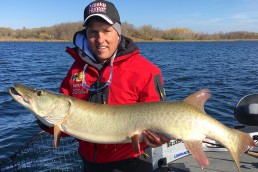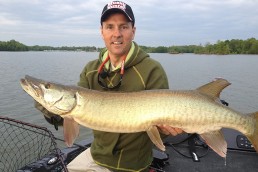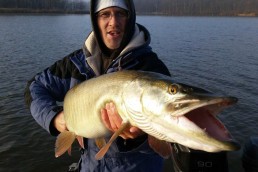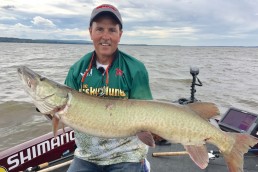Unwrap the Secret to More Muskies
SHARE THIS POST
One of the things I really enjoy is teaching people how to catch more muskies. I started muskie schools with my good friend Joe Bucher back in 1982. When Joe decided to stop teaching his muskie schools, Steve Heiting and I started the University of Esox in 1996.
Throughout the years I’ve been able to fish with many muskie anglers of different skill levels. Many of the students have become excellent anglers, some of which are now top guides and in tournaments. What is interesting is that having taught fishing schools for 30 years, there are a few skills that many muskie anglers continue to overlook, and instead focus on a specific lure technique such as working a glider jerkbait or ripping a crankbait on a weed edge.
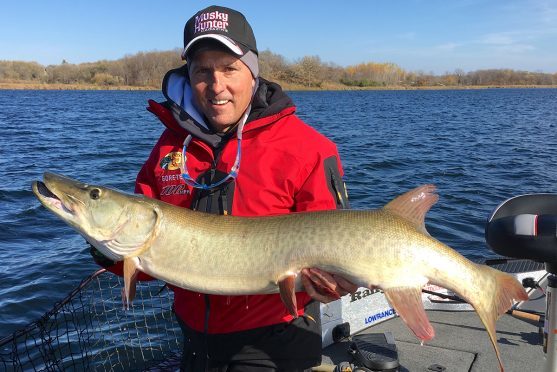
Although developing lure techniques will make you a better muskie angler, there are three skills needed over the long haul. Perfecting this trio will put more muskies in your boat more than any one technique by lure. The three must-have skills are casting, figure eights and boat control.
Let’s examine the importance of each as food for thought during the winter months.
Most muskie anglers I encounter are pretty good with a baitcaster, but they could become much better. Also, since we often make long casts to non-specific targets, these anglers aren’t nearly as accurate as bass anglers when it comes to hitting their targets. It’s extremely important to focus on reducing backlashes with your reel and being able to make both long casts as well as shorter, more accurate casts to the targets.
How many backlashes do you get in a day? If you answered more than a handful, your casting needs some work.
Actually, with today’s reels having both a break system and magnetic cast control, there really is no reason your goal shouldn’t be to have only a handful of backlashes each season. The most common reason for the backlash is improper reel position at the beginning of a cast. If you’re right-handed, you should begin your cast with the reel handle pointed up toward the sky. If you are left-handed, start with your reel hand pointed down. Most anglers start their cast with the reel handle pointed to the side. This puts you in the wrong position and adds more pressure to your thumb. Over time, your thumb fatigues and you get backlashes. If you start with your handle up you use your wrist more, which places less pressure on your thumb to control the cast, resulting in fewer backlashes.
Are you enjoying this post?
You can be among the first to get the latest info on where to go, what to use and how to use it!
Reducing backlashes is extremely important. Besides a wasted cast, backlashes can result in lost lures on a windy day when fishing around rocks or other dangerous shallow cover. Backlashes can damage your line, and even 100-pound-test braid can be weakened. Multiple backlashes can result in the line breaking on a hook-set, or on another backlash. This can cause you to lose a lure, or even worse, a muskie. Concentrate on your casting position and focus on what you’re doing and you’ll significantly reduce these.
When casting, even to open water, pick an imaginary target to land your lure. Try making long casts as well as short. When casting close to cover, try picking precise spots to place your lure. Try a contest with your boat partner—it’s amazing how quickly your casting accuracy can improve. This will ultimately result in more muskies as you can cast to weed edges and pockets, resulting in less lure fouling and more strikes. Muskie fishing is a game of percentages, and throughout a long day the more casts without backlashes and without fouling in weeds or rocks will produce more strikes.
There have been lots of articles and videos that illustrate the figure eight, but every year I meet many muskie anglers—particularly beginners—who don’t believe it really works. The more experienced anglers who don’t catch muskies in figure eights, well, let’s just say that my experience has told me that their eights need some work. Figure eights take a focus that requires you to have to anticipate a lure getting close to the boat and make the first turn big and fast. Then, you have to move along the straightaway and make another turn. You typically only need 12 to 18 inches of line between the lure and the rod tip. And certainly a longer rod, such as an 8-foot-6-inch Shimano Compre, can really help you make big turns during the figure eight. I’ll tell people to figure eight the lure and not the rod, as this keeps the lure moving in the water—you don’t want to ruin the action. Keep the muskie’s interest, and don’t be afraid to go deep or shallower with the figure eight if the fish maintains interest and keeps following.
I try to remain calm and watch how the fish is responding during the figure eight: If it follows a fast turn quickly, I’ll move the lure along in the straight path and go into the next turn, but if I use a slight hesitation, I’ll move the lure at the end of the turn. It’s not a pause or stop, but a hesitation or split-second hang. If you’re fishing a Cowgirl, you’ll see the flashaboo flare for a second. Then move back into the straight portion of the figure eight. Quite often, the hesitation move will result in a strike or the muskie might snap and miss the lure. Repeat the hesitation on the next turn, slowing down slightly, and the muskie is yours. In some situations the muskie tends to drop back from the lure, so go slower and deeper with the figure eight. Often, the muskie might disappear and then reappear 30 seconds later and bite, so don’t quit on a slow or deep follow.
Think about those tough days on the water with minimal follows, where it seems like there are no muskies in the lake. Where do you usually get a strike? It’s at boat side. You have to remain focused and committed to the figure eight on every cast, as the one bite you most likely will get on those tough days is a figure-eight strike. That’s why I believe practicing and focusing on the figure eight is more important than learning any specific lure technique.
The final point is to consider is boat control. We have all heard the cliché you have to make the right cast to the right spot to catch a fish. Well, making that cast relies upon boat control. If your boat is too close to the cover or too far away from it, you won’t catch muskies. You have to visualize how a spot looks, where the muskies might be located and then decide how to fish the spot. Most of the time I’ll work into the wind and use my trolling motor to slowly work the area. If I have a follow or find an area I want to make a couple extra casts, I simply step off the trolling motor and the wind will let me drift away from that spot and I then make more casts. Plus, I’ll use my Lowrance GPS to mark the spot to be able to precisely return to the area. Anyone can work the boat on calm days, but it’s the windy days where boat control makes a difference. Work on your boat control, as it’s the equalizer.
These tips may seem fundamental, and they are, but they’re also the building blocks for a successful season. Think about how you cast, figure eight and run your boat. If you strive to get better, I’ll guarantee you’ll catch more muskies.
MWO
SHARE THIS POST
Did you enjoy this post?
You can be among the first to get the latest info on where to go, what to use and how to use it!
Jim Saric
Jim Saric is a Legendary Angler in the Freshwater Fishing Hall of Fame, the host and executive producer of The Musky Hunter television series, editor at large of Musky Hunter magazine, a seven-time muskie tournament winner, and a contributing writer for numerous other publications.
